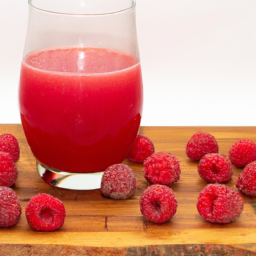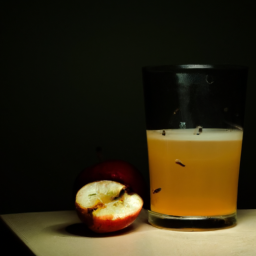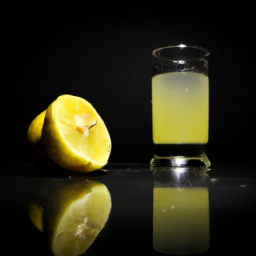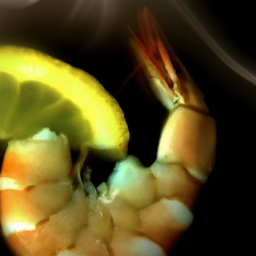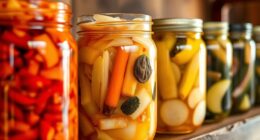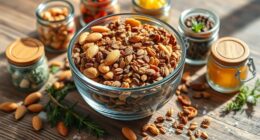Juicing has become increasingly popular as a way to boost our consumption of fruits and vegetables. It provides an easy and convenient way to get the necessary nutrients our bodies need, all while satisfying our taste buds.
One fruit that is often overlooked in the juicing world is the pear. However, pears are a great addition to any juice blend, providing a sweet and refreshing flavor while also offering numerous health benefits.
Firstly, it’s important to note the many benefits of juicing pears. Pears are a great source of fiber, which can aid in digestion and promote feelings of fullness. They also contain antioxidants, which can help protect our cells from damage and reduce the risk of chronic diseases. Additionally, pears are a good source of vitamin C, which can boost our immune system and promote skin health.
By incorporating pears into our juice blends, we can reap all of these benefits while also enjoying a delicious and refreshing beverage.
Key Takeaways
- Pears are a great source of fiber, antioxidants, and vitamin C, making them a healthy addition to any juice.
- Complementary fruits and vegetables, such as apples, carrots, and ginger, can enhance the flavor and nutrition of pear juice.
- Using a masticating juicer at a low speed is recommended for juicing pears to prevent bitterness from the pear seeds.
- Properly storing fresh pear juice in the fridge can extend its shelf life up to 3 days.
Benefits of Juicing Pears
You’re going to love how juicing pears can give you an instant energy boost and improve your digestion! Pears are low in calories and high in fiber, making them a great addition to any juicing recipe. They’re also rich in vitamins and minerals, including vitamin C, vitamin K, and potassium.
Juicing pears can help you meet your daily nutritional requirements and give you a much-needed energy boost to power through your day. There are many delicious recipes that you can try when juicing pears. One of my favorites is a simple pear and ginger juice.
To make this recipe, simply blend together pears, ginger, and a bit of water until smooth. Not only is this juice delicious, but it’s also packed with nutrients that your body needs. So, if you’re looking for a healthy and tasty way to get your daily dose of vitamins and minerals, juicing pears is definitely worth trying!
Now, let’s move on to choosing the right pears for your juicing recipes.
Choosing the Right Pears
When selecting the perfect pear for juicing, it’s important to consider its ripeness, sweetness, and texture. Different pear varieties have varying degrees of sweetness and texture, so it’s important to know which type of pear is best for juicing. Some of the most popular pear varieties for juicing include Bartlett pears, Anjou pears, and Bosc pears.
The best time to buy pears for juicing is when they are fully ripe but not overripe. Look for pears that are slightly soft to the touch and have a sweet aroma. Avoid pears that are bruised or have soft spots, as they may not be suitable for juicing.
Once you have selected the perfect pears, it’s time to prepare them for juicing.
Preparing the Pears
To get your pears ready for the juicer, it’s time to start peeling and slicing them into manageable pieces. When it comes to peeling techniques, I prefer to use a vegetable peeler as it allows me to remove the skin with ease while also preserving as much of the flesh as possible. However, if you don’t have a peeler on hand, you can also use a knife to carefully remove the skin.
Once the pears are peeled, it’s important to slice them into pieces that will fit comfortably into your juicer. The ripeness of the pears will also play a role in how easy they are to slice. If the pears are too ripe, they may be too soft to slice without falling apart. On the other hand, if the pears are not ripe enough, they may be too hard to slice easily. To make the process easier, I recommend choosing pears that are slightly ripe, but still firm to the touch. With your pears sliced and ready to go, it’s time to move on to choosing additional ingredients to add to your juice.
Choosing Additional Ingredients
When choosing additional ingredients to add to my pear juice, I always consider complementary fruits and vegetables that will enhance the flavor and nutrition of the juice.
For example, adding apples or carrots can add natural sweetness, while adding spinach or kale can boost the antioxidant content.
I also like to experiment with herbs and spices, such as ginger or mint, to add a refreshing and aromatic touch to the juice.
Overall, selecting the right additional ingredients can elevate the taste and health benefits of my homemade pear juice.
Complementary Fruits and Vegetables
You’ll want to pair your pears with complementary fruits and vegetables to create a well-balanced and flavorful juice. Here are some pairing suggestions to help you get started.
-
Apples: Pears and apples are a classic combination that work well together in juice. They both have a similar texture and sweetness, and apples add a slightly tart flavor that complements the pear.
-
Carrots: Adding carrots to your pear juice will boost its nutritional value. Carrots are high in vitamin A and antioxidants, which can help improve your skin health and boost your immune system.
-
Ginger: If you want to add a little spice to your pear juice, try adding some ginger. Ginger can help improve digestion and reduce inflammation, making it a great addition to any juice.
Incorporating these complementary fruits and vegetables can add depth and complexity to your pear juice, making it a well-rounded and nutritious drink.
Moving on to the next section, let’s explore how herbs and spices can enhance the flavor of your pear juice even further.
Herbs and Spices
Now that we’ve discussed the importance of combining complementary fruits and vegetables, let’s move on to the use of herbs and spices in juicing.
Adding herbs and spices to your juice can not only enhance the flavor, but also provide numerous health benefits. For example, adding ginger to your pear juice can aid in digestion and reduce inflammation. Mint can have a calming effect on the digestive system and help with nausea. Turmeric is a powerful anti-inflammatory and can also boost the immune system.
These herbs and spices can easily be added to your juicer along with your pears and other fruits and vegetables for an added kick of flavor and health benefits.
As we continue to explore the world of juicing, let’s now move on to the techniques used to juice pears and other fruits.
Juicing Techniques
First, grab your juicer and quarter your pears to prepare for juicing. When it comes to juice extraction, using the right juicing equipment is key. I prefer using a masticating juicer as it’s known to preserve the nutrients and enzymes better than a centrifugal juicer. Additionally, make sure the juicer is set to a low speed to avoid heating the juice, which can also destroy nutrients.
Next, choose your juicing technique. One option is to juice the pears on their own, but you can also mix them with other fruits and vegetables to create a more complex flavor profile. For example, try adding ginger and lemon to your pear juice for a spicy kick. Or, mix in some kale and cucumber for added nutrients and freshness.
Once your juice is ready, you can adjust the flavor by adding some honey, cinnamon, or even a splash of apple cider vinegar. By adjusting the flavor, you can create a juice that’s perfectly suited to your taste preferences.
So, whether you prefer a sweet and fruity juice or something with a bit of a kick, don’t be afraid to experiment with different ingredients and flavors.
Adjusting the Flavor
To add some extra pizzazz to your pear juice, consider adjusting the sweetness and balancing the acidity. Pears are naturally sweet, but depending on the ripeness of the fruit and personal preference, you may want to adjust the sweetness level.
If your pears are not quite ripe yet, add a little bit of honey or maple syrup to sweeten things up. If your pears are very ripe and already quite sweet, you may want to balance the sweetness with a squeeze of lemon juice or a dash of cinnamon.
Additionally, if you find that your pear juice is a bit too acidic, you can balance it out with a little bit of sweetness. Again, honey or maple syrup are great options, but you can also try adding a pinch of salt or a few drops of vanilla extract.
Taste as you go and adjust as needed until you find the perfect balance of sweetness and acidity in your pear juice.
Next, let’s talk about how to store and serve your freshly juiced pear juice.
Storing and Serving
Now that I’ve successfully juiced my pears, it’s important to know how to store and serve them properly.
Refrigeration is the best option for storing fresh pear juice, as it can last up to 3 days. Freezing is also an option but note that the texture and flavor may slightly change.
When serving, I recommend adding a splash of lemon juice or ginger for extra flavor and garnishing with a slice of pear or a sprig of mint.
Refrigeration and Freezing
Refrigerating or freezing your pears is essential to maintain their quality and extend their shelf life. Proper storage can help avoid texture changes and spoilage, ensuring that your pears remain fresh and delicious for longer.
When refrigerating pears, place them in a plastic bag and store them in the crisper drawer. This will help prevent moisture loss and keep the fruit from becoming too soft.
If you want to freeze your pears, start by washing and peeling them. Cut them into slices or chunks and remove the seeds. Dip the pieces in a solution of water and lemon juice to prevent browning. Place the prepared pears in a freezer-safe container or bag and store them in the freezer. Frozen pears can last for up to 6 months and are perfect for smoothies or baking recipes.
When you’re ready to serve your pears, there are many different options to choose from. You can eat them as a snack, add them to salads or cheeseboards, or use them as a topping for oatmeal or yogurt. Pears also make a tasty addition to baked goods, such as pies, tarts, and muffins.
With so many possibilities, there’s no limit to the ways you can enjoy this sweet and versatile fruit.
Serving Suggestions
When serving your pears, you can impress your guests with the fact that over 95% of pears grown in North America are of the Bartlett variety, making it the most popular pear in the region. To make the presentation even more appealing, consider serving sliced pears on a decorative platter or arranging them in a fruit bowl. You can also add a pop of color by garnishing with fresh mint leaves or berries.
Here are some pairing suggestions to complement the juicy sweetness of your pear juice:
- Cheese: Pears pair well with a variety of cheeses, such as brie, gouda, or blue cheese. Serve a platter of cheese and pear slices for a sophisticated appetizer.
- Wine: A crisp white wine, such as Sauvignon Blanc or Pinot Grigio, is a great match for the delicate flavors of pears. For a sweeter option, try a Riesling or Moscato.
Now that your guests have enjoyed their refreshing pear juice and complementary pairings, it’s time to clean up and prepare for the next course.
Cleaning Up
Ready to enjoy your deliciously fresh pear juice? Before you start sipping, don’t forget to give your juicer a thorough cleaning to keep it in tip-top shape for your next juicing adventure! Here are some clean-up tips to help you maintain your juicer:
First, unplug your juicer and disassemble it. Rinse all the parts under running water to remove any pear residue. Use a soft brush to scrub any hard-to-reach areas.
Make sure to clean the mesh strainer thoroughly, as it can easily get clogged with pulp. Once you’ve cleaned all the parts, dry them with a clean towel before reassembling your juicer.
Dispose of any leftover pear scraps in a compost bin or trash can.
Now that your juicer is all clean, it’s time for some tips and tricks to help you get the most out of your pear juice.
Tips and Tricks
When juicing pears, there are a few tips and tricks that I’ve found useful in maximizing yield and avoiding bitterness.
First, make sure to choose ripe pears that are soft to the touch but not mushy. This will ensure the sweetest and most flavorful juice.
Second, I recommend using a slow juicer rather than a centrifugal juicer to prevent bitterness from the pear seeds.
Finally, if you do notice any bitterness, try adding a small piece of ginger or lemon to balance it out.
Maximizing Yield
To get the most juice out of your pears, try squeezing them with a cheesecloth or using a juicer. Here are some tips to help you maximize your yield:
-
Use ripe pears: Ripe pears contain more juice than unripe ones. Choose pears that are slightly soft to the touch and have a sweet aroma.
-
Cut them into small pieces: Smaller pieces are easier to juice than larger ones. Cut your pears into small chunks or thin slices before juicing.
-
Press the pulp: After juicing, use a spoon to press down on the pulp and extract any remaining juice.
-
Use leftover pulp: Don’t throw away the leftover pulp! It can be used in a variety of ways, such as adding it to smoothies or using it to make pear sauce.
-
Try DIY pear juice without a juicer: If you don’t have a juicer, you can still make pear juice by blending the pears with a little water and straining the mixture through a fine-mesh sieve or cheesecloth.
By following these tips, you can get the most juice out of your pears and reduce waste.
Next, let’s talk about how to avoid bitterness in your pear juice.
Avoiding Bitterness
If you’ve ever tasted bitter pear juice, you know how disappointing it can be. One way to avoid this is to choose the right pear variety. Certain varieties, like Bartlett and Anjou, are sweeter and less likely to produce bitter juice. On the other hand, Bosc and Comice pears are more prone to bitterness.
Additionally, make sure to use ripe pears for juicing. Unripe pears contain more tannins, which can cause bitterness. Another way to avoid bitterness in pear juice is to cook it. Cooking breaks down the tannins and reduces their bitterness. This also adds a depth of flavor to the juice.
You can use cooked pear juice in a variety of recipes, from cocktails to marinades. When cooking pear juice, start by simmering it over low heat until it reduces by half. This concentrates the flavors and reduces the bitterness. Then, let the juice cool and strain it before using it in your recipe.
Frequently Asked Questions
Can you use canned pears for juicing?
Yes, canned pears can be used for juicing, but fresh pears are more nutritious. Canned pears lose some of their nutritional value during processing and may contain added sugars.
Is it necessary to peel the pears before juicing?
To peel or not to peel? While the skin of pears contains valuable nutrients like fiber and antioxidants, it can also contain pesticides or wax. Ultimately, peeling is optional and depends on personal preference and quality of the fruit.
How many pears do I need to make a glass of juice?
To make a glass of pear juice, I usually juice about 3-4 medium-sized pears. As for pairing flavors, ginger and lemon complement the sweetness of pear juice and add a little kick to the taste.
Can I mix pears with other fruits or vegetables in my juice?
Yes, mixing pears with other fruits or vegetables can enhance the flavor and nutritional value of your juice. However, pear juice alone has many benefits, including aiding digestion and promoting heart health. The best time to drink pear juice is in the morning on an empty stomach.
How long can I store pear juice in the refrigerator?
Storing pear juice in the refrigerator is a great option, but it’s important to consume it within 2-3 days. Alternatively, freezing the juice in ice cube trays or airtight containers can extend its shelf life. Pear juice is also rich in antioxidants, making it great for maintaining healthy skin.
Conclusion
Overall, juicing pears is a delicious and nutritious way to incorporate more fruits into your diet. Not only do pears provide a sweet and refreshing taste, but they also offer a variety of health benefits such as aiding digestion and promoting heart health.
By following the steps outlined in this article, you can easily juice pears at home and experiment with different flavor combinations to find your perfect blend.
One potential concern with juicing pears is the sugar content. While pears do contain natural sugars, they’re low on the glycemic index and won’t cause spikes in blood sugar levels like processed sugars do. Additionally, juicing allows for the removal of the fiber in the fruit, which can help slow down the absorption of sugar into the bloodstream.
As with any food or drink, moderation is key, but don’t let concerns about sugar content deter you from enjoying the delicious and nutritious benefits of juicing pears.
Hi, I’m Alexander. I’m a vegan of over 20 years, and I initially made the switch for health reasons. However, as time went on, I became more and more passionate about the ethical and environmental implications of leading a vegan lifestyle.
I am the author of The Graceful Kitchen, a vegan blog where I share recipes for delicious and nutritious vegan meals. As someone who is deeply committed to living a cruelty-free life, I am also a strong advocate for using whole foods as the foundation of a healthy diet – and believe that going vegan is one of the best ways to achieve this.

